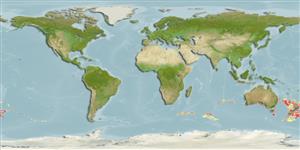Common names from other countries
Holocephali (quimeras) (chimaeras) >
Chimaeriformes (Chimaeras) >
Chimaeridae (Shortnose chimaeras or ratfishes)
Etymology: Hydrolagus: hydro-, combining form of hydor (Gr.), water; lagos (Gr.), hare, i.e., “water rabbit,” probably referring to three pairs of tooth plates, which tend to protrude from the mouth like a rabbit’s incisors. (See ETYFish); homonycteris: homo-, from hominis (L.), man; nykteris (Gr.), bat, referring to Thomas A. Griffiths, bat systematist known as “bat man,” who introduced Didier to chimaeroid fishes. (See ETYFish).
Environment: milieu / climate zone / depth range / distribution range
Ecologia
marinhas batidemersal; intervalo de profundidade 866 - 1447 m (Ref. 76967). Deep-water
Southern Ocean: Australia and New Zealand.
Length at first maturity / Tamanho / Peso / Idade
Maturity: Lm ?, range 85 - ? cm
Max length : 109 cm TL macho/indeterminado; (Ref. 76967)
Descrição breve
Chaves de identificação | Morfologia | Morfometria
This chimaeroid fish has a ventral caudal fin that that is not indented at its origin to form a separate anal fin, it is distinguished from its congeners by the following characters: color of the body an even dark black or blackish-brown; its dorsal fin spine is longer than height of first dorsal fin; pelvic fins is distinctly round in shape; males with pelvic claspers that are dark at the base with pale tips, divided for the distal 1/3 of their length (Ref. 76967).
Life cycle and mating behavior
Maturities | Reprodução | Spawnings | Egg(s) | Fecundities | Larvas
Didier, D.A., 2008. Two new species of the genus Hydrolagus Gill (Holocephali: Chimaeridae) from Australia. In Last, P.R., White, W.T. & Pogonoski, J.J. (eds.): Descriptions of New Australian Chondrichthyans. CSIRO Marine and Atmospheric Research Paper no. 22. (Ref. 76967)
Categoria na Lista Vermelha da IUCN (Ref. 130435)
CITES (Ref. 128078)
Not Evaluated
Ameaça para o homem
Harmless
Utilização humana
Ferramentas
Relatórios especiais
Descarregue XML
Fontes da internet
Estimates based on models
Preferred temperature (Ref.
115969): 2.2 - 5.7, mean 4.6 (based on 177 cells).
Phylogenetic diversity index (Ref.
82804): PD
50 = 0.5000 [Uniqueness, from 0.5 = low to 2.0 = high].
Bayesian length-weight: a=0.00275 (0.00138 - 0.00549), b=3.08 (2.90 - 3.26), in cm Total Length, based on LWR estimates for this species & (Sub)family-body (Ref.
93245).
Nível Trófico (Ref.
69278): 3.9 ±0.6 se; based on size and trophs of closest relatives
Resiliência (Ref.
120179): Muito baixo, tempo mínimo de duplicação da população maior que 14 anos (Preliminary K or Fecundity.).
Fishing Vulnerability (Ref.
59153): High to very high vulnerability (65 of 100).
